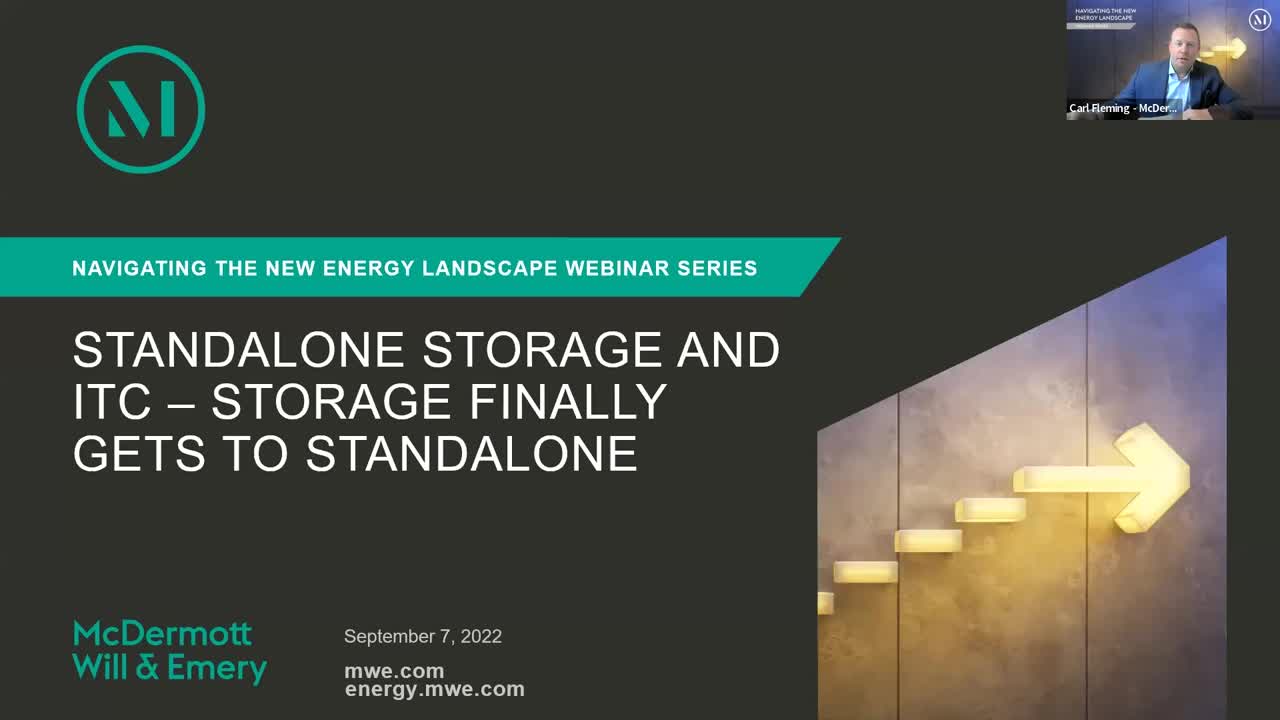Overview

The passage of the landmark Inflation Reduction Act of 2022 (IRA) is a long-awaited and critical win for standalone energy storage system projects. On September 7, during the latest webinar in our Navigating the New Energy Landscape series, McDermott Partners Carl Fleming and Philip Tingle hosted Chris McKissack, CEO of GlidePath, and Caitlin Smith, senior director of regulatory, external affairs and ESG at Jupiter Power, for a discussion on the new investment tax credit (ITC) for standalone energy storage under the IRA and its impact on the energy storage market.
Below are key takeaways from the discussion:
- Impact of the IRA on business models: The developers and operators who have been following a sniper approach to storage projects for years are certainly benefiting from the tax credits provided by the IRA to the standalone storage business. The IRA puts experienced participants in the standalone storage business on a level playing field, further justifies their existing business plans and provides a stronger booting for opportunities already in the pipeline. With the introduction of the standalone ITC, we expect to see an increase in competition and new participants in the business, as well.
- Impact of decoupling from wind and solar: Before the IRA, there was always a question about whether a storage system could be coupled with or located near a production tax credit (PTC) project (such as a wind project) and be eligible for the ITC independent of wind or PTC resources. The IRA answered the question, and the answer is yes. Under the IRA, energy storage market participants are now able to decouple battery storage from other renewable projects, as the requirement to charge 75% of the time from solar is removed when paired with other technologies. This gives energy storage projects the ability to operate more optimally and capture additional revenue or savings. From a commercial perspective, it has yet to be seen whether the potential storage assets will be truly standalone with separate revenue and ITC monetization or whether transferability will be the primary source. The storage business is much more than its buy low and sell high mentality; it is a new and flexible resource that helps with congestion, stability and voltage support and can respond in less than three seconds.
- Impact of the IRA on standalone storage, transmission and project development: The ITC and its reduction of 30% to the capital cost of equipment will further increase the viability of storage to enable developers to offer grid services to utilities at attractive prices. This is crucial to replacing the country’s fleet of fossil fuel plants because it integrates the increasing amounts of wind, solar and hydropower that is being transmitted hundreds of miles without jeopardizing grid reliability. The IRA provides incentives for storage projects to site and plug in the energy communities and to construct and build out the storage capacity simultaneously with the build-out of new planned renewable projects, instead of waiting on such renewable energy recourses to come online first.
- Issues raised by the IRA’s domestic content and placed in service requirements: With the new standalone ITC and the domestic content incentives for storage components, standalone storage projects can receive the ITC independently from wind and solar. While this is a good thing, it also comes with its own set of wrinkles. One new question that is being asked frequently is when developers need to show placed in service for standalone storage projects. This question matters as it impacts transferability and who is entitled to receive the ITC on a storage system—and we expect more regulatory guidance to come.
- Outlook on the battery storage supply chain: Like every segment of our nation’s economy, the energy storage industry is reeling from unforeseen costs and supply chain delays and facing uncertain external risks and market-based obstacles that must be acknowledged and addressed if we are to stay on track to aggressively fight climate change by investing and constructing energy storage projects that support dual goals of renewable energy and grid resiliency. There are incentives in the IRA for both electric vehicles (EVs) and battery storage. Both industries use a lot of the same materials and processes, which is both a challenge and a benefit. On the one hand, there is more competition as participants in both spaces are trying to compete for the same resources. On the other hand, the standalone storage business also benefits from the research and development that the automotive EV space has done, such that in the long term, the benefit will outweigh the complications of competing for a limited supply chain of materials and ramp up both spaces at the same time.
To access past webinars in the Navigating the New Energy Landscape series and to begin receiving Energy updates, including invitations to the webinar series, please click here.








